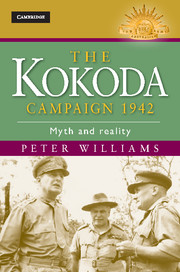Book contents
- Frontmatter
- Contents
- Photographs
- Maps
- Tables
- Key to military symbols
- Acknowledgements
- Note on the text
- Glossary
- Chapter 1 Introduction
- Chapter 2 Strategy
- Chapter 3 Military intelligence
- Chapter 4 The Nankai Shitai
- Chapter 5 From the landing to Deniki
- Chapter 6 Isurava
- Chapter 7 Guadalcanal and Milne Bay
- Chapter 8 The Japanese build-up
- Chapter 9 First Eora–Templeton’s
- Chapter 10 Efogi
- Chapter 11 Ioribaiwa
- Chapter 12 Japanese Artillery
- Chapter 13 Malaria and dysentery
- Chapter 14 The Japanese supply crisis
- Chapter 15 Second Eora–Templeton’s
- Chapter 16 Oivi–Gorari
- Chapter 17 The war in the air
- Chapter 18 Conclusion
- Note on sources
- Notes
- Bibliography
- Index
Chapter 12 - Japanese Artillery
Published online by Cambridge University Press: 05 November 2013
- Frontmatter
- Contents
- Photographs
- Maps
- Tables
- Key to military symbols
- Acknowledgements
- Note on the text
- Glossary
- Chapter 1 Introduction
- Chapter 2 Strategy
- Chapter 3 Military intelligence
- Chapter 4 The Nankai Shitai
- Chapter 5 From the landing to Deniki
- Chapter 6 Isurava
- Chapter 7 Guadalcanal and Milne Bay
- Chapter 8 The Japanese build-up
- Chapter 9 First Eora–Templeton’s
- Chapter 10 Efogi
- Chapter 11 Ioribaiwa
- Chapter 12 Japanese Artillery
- Chapter 13 Malaria and dysentery
- Chapter 14 The Japanese supply crisis
- Chapter 15 Second Eora–Templeton’s
- Chapter 16 Oivi–Gorari
- Chapter 17 The war in the air
- Chapter 18 Conclusion
- Note on sources
- Notes
- Bibliography
- Index
Summary
The Kokoda myth explanation that the Australian defeats in the first half of the Kokoda campaign were a result of being greatly outnumbered has been shown to be untrue. An alternative might be that Japanese artillery had a lot to do with explaining the outcome of the battles on the Kokoda Track. The Nankai Shitai brought 16 artillery pieces to Papua. They took 13 of them into the mountains, although not all were used there, and employed 15 at Oivi–Gorari, the final battle of the campaign. Artillery can determine the outcome of battles, especially where the opponent has none. The ability to concentrate artillery fire on a single point on a battle front can significantly affect the opposing infantry and lessen the advantage of prepared defensive positions. Even a few guns when used well can do so, but not much has been written about Japanese artillery during the Kokoda campaign.
Postwar accounts have mentioned the effectiveness of Japanese mortar fire, and there has been an assumption that the main Japanese long-range weapon was, together with a mountain gun or a 37mm Quick Firing (QF) gun or two, the 81mm medium mortar. But of the hundreds of Japanese rounds recovered during the campaign and since, not one mortar round of this size has been found on the Kokoda Track. In Melbourne in early 1942 a facility was established to test Japanese equipment, ammunition and weapons. As rapidly as possible samples were sent there from the battlefield, yet no Japanese medium-mortar rounds appeared in Melbourne until after 15 December 1942 simply because no Japanese medium mortars were used in the Owen Stanley Range. The only ones used in Papua were in the defence of Buna–Gona from late November 1942. It should be noted here that we are not talking about the ‘knee mortar’, a light mortar. There were three of these organic to each Japanese infantry platoon. These were short-range weapons incapable of filling the role of artillery as, to some extent, the medium mortar was.
- Type
- Chapter
- Information
- The Kokoda Campaign 1942Myth and Reality, pp. 152 - 161Publisher: Cambridge University PressPrint publication year: 2012



